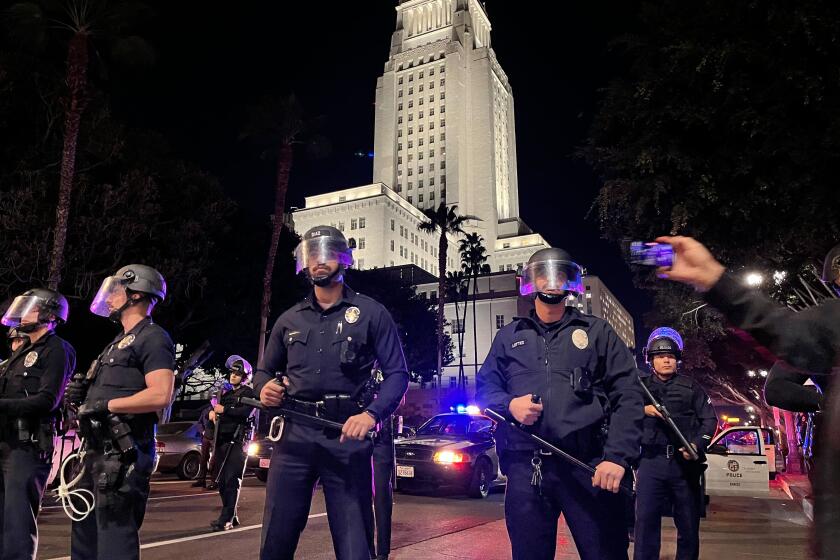Coming back to life after the Holocaust
- Share via
“Happy birthday!” my mom and her first cousin will wish each other on Sunday, even though neither was born on Jan. 27. Rather, it’s the anniversary of their new lease on life, of the day the Soviet Red Army liberated them from behind the barbed wire of Auschwitz-Birkenau in 1945.
My mom, Rena Margulies Chernoff, was 11 then, and her cousin Frieda Tenenbaum was 10. They were among the very few children who somehow survived the infamous death camp, where more than a million people — mostly Jews, including more than 200,000 children, but also gays, Poles, Soviet prisoners of war, Roma and Sinti (Gypsies) — were slaughtered.
For many years after their liberation, Rena, Frieda and a few other Auschwitz child survivors gathered to celebrate their “birthday,” sharing tears and laughter, flowers, food and drink. Together, they explored their tragic past, and in doing so helped each other to heal.
It didn’t seem likely, in those last days before the Soviets arrived, that my mother and her cousin would survive. Nazi guards ordered prisoners to line up by the camp’s gates for evacuation marches. Rena, Frieda and their mothers, convinced they couldn’t survive a death march, sneaked off to a deserted barracks to hide under the wood slats of the lowest bunk. They quietly cowered against the frozen ground as Nazi guards screamed “Alle Juden Raus!” (“All Jews Out!”) and scoured the camp for stragglers, who were then shot to death.
Silence eventually replaced the sounds of violence. The guards had evacuated, allowing the girls and their mothers to return to the hospital barracks that had been their most recent shelter. Even so, death surrounded them. Starving musselmen, a term for the most physically and emotionally spent prisoners, collapsed and died before their eyes.
Those who retained a bit of strength raided the kitchen and broke into a warehouse, where they found blankets and layers of clothing to protect against the cold. But the situation was still desperate.
A week later, Jan. 27, 1945, dawned clear and brilliantly sunny at Auschwitz. Prisoners first noticed what appeared to be dogs off in the distance, tramping through deep snow. But as the figures approached it became clear they were soldiers, bundled in coats and fur hats, approaching the camp. When they realized it was the Soviets, who had come to liberate them, many of the survivors hugged one another and cried with joy.
But some of the inmates, including my mother, weren’t capable of elation. She describes feeling numb, ill with tuberculosis and struggling to come to terms with all she had endured.
Indeed, the Soviet soldiers themselves were unprepared for the pitiful sights they encountered in the camps. Their leader, Gen. Vasily Petrenko, entered the hospital barracks and broke down in tears.
An army film crew soon afterward handed Rena a striped prisoner’s uniform to wear, then recorded her and other children walking past a barbed-wire fence. That widely aired footage left the misimpression children in the camp had worn such uniforms. In fact, striped uniforms were for the slave laborers who worked outside the camp in brigades known as Aussenkomandos. (Upon arrival at Auschwitz, most female prisoners, including Rena, Frieda and their mothers, received dresses taken from murdered prisoners.)
Liberation did not instantly free my mother to regain her humanity. It returned gradually. At a displaced persons camp, among a community of survivors, she filled in gaps in her education and played with friends, free from fear that her laughter and cheer could get her killed. Upon arrival in the United States, she found the love of a larger family, which embraced her and assisted in her adjustment to a new country. She learned to live by living life again, eventually starting a career and a family.
To be sure, the effect of Auschwitz on a survivor never disappears; it merely recedes. But celebrating one’s liberation as a birthday has been an effective way for these miracle children — now among the last remaining Holocaust survivors — to reaffirm life and move beyond trauma.
Rena and Frieda’s group of Auschwitz survivors no longer gathers each year to celebrate the anniversary of their rescue. Age, illness and physical distance make that impossible. And before long, even the youngest of them will be gone.
Their “birthday,” though, must be remembered.
In declaring Jan. 27 International Holocaust Remembrance Day, the United Nations General Assembly urged its member states “to develop educational programs that will inculcate future generations with the lessons of the Holocaust in order to help to prevent future acts of genocide.”
Remembering — and educating others about the importance of remembrance — is the best possible tribute to the victims and survivors, the best tool we have to give power to our cry, “Never again!”
Allan Chernoff is a former senior correspondent for CNN and CNBC. He is completing a communal memoir of the survivors of the town of Tomaszow Mazowiecki, Poland.
More to Read
A cure for the common opinion
Get thought-provoking perspectives with our weekly newsletter.
You may occasionally receive promotional content from the Los Angeles Times.






